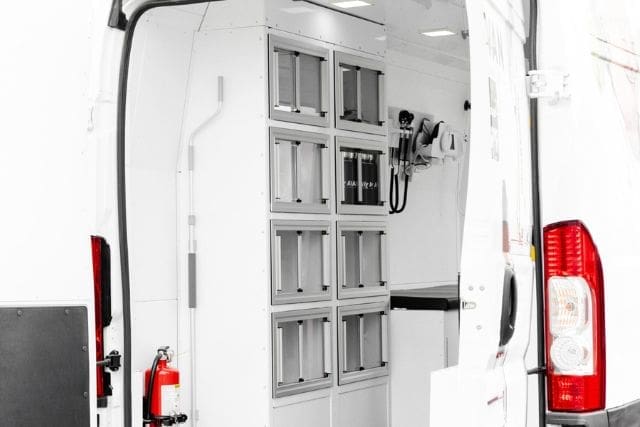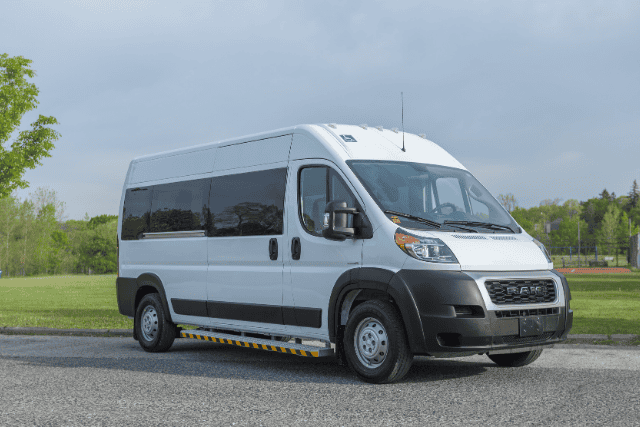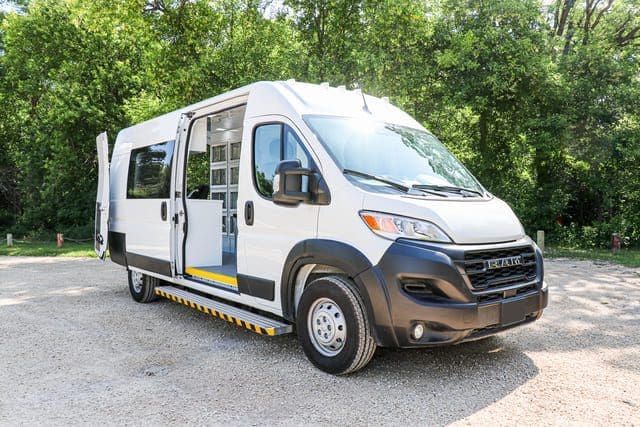When your organization is considering purchasing a mobile clinic, the process can feel overwhelming. You’re likely trying to navigate a maze of options, features, and costs while keeping the needs of your community in mind. Your decision will impact the quality of care you provide, so it’s important to get it right.
The last thing you want is to invest in a mobile clinic that doesn’t fully meet your needs or, worse, creates more problems than it solves. It’s a big responsibility, and you might be feeling the weight of it. Some problems the wrong mobile clinic could cause are:
- Staff burnout
- Spoiled vaccines
- Few people served
At AVAN Mobility, we know about the challenges you’re facing. With over 10 years of experience in building mobile health clinics for organizations like Celebrating Life Community Health Center and yours, we’ve seen what works and what doesn’t. Our mission is to help people help people and reduce barriers to healthcare by creating vehicles that are as practical as they are innovative. We’ve learned a lot about what to look out for, and we’re here to share that knowledge with you.
While we believe in the quality of our products, we also know that transparency is key. We’re not the only manufacturer out there, and we’re here to guide you in making an informed decision that’s right for your organization.
In this article, you’ll learn about the top five pitfalls to avoid when purchasing a mobile clinic. Knowing these common mistakes can save you time, money, and frustration and help you choose a mobile medical vehicle that truly serves your target community’s needs.
What are the top 5 pitfalls to avoid when purchasing a mobile clinic?
In this section, you’ll learn all about the most common pitfalls organizations like yours should try to avoid when in the process of buying a mobile clinic.
1. Overcomplicating things
One of the biggest pitfalls when purchasing a mobile clinic is trying to do too much all at once. It’s easy to get caught up in the excitement of building a mobile health clinic and wanting to include every feature possible. But here’s the thing: healthcare needs change, and they can change quickly.
If you build a clinic that’s too specialized or tailored to one specific type of care, you might find yourself stuck if those needs shift. Instead, focus on creating a versatile, adaptable mobile clinic that can meet various healthcare needs.
Here’s why simplicity works:
Flexibility: A basic ‘doctor’s office on wheels’ setup can be used for a wide range of services, from general check-ups to vaccinations and even mental health consultations.
Agility: When you keep things simple, your organization can quickly respond to new challenges and changing needs in your community.
Preparedness: Simple doesn’t mean less effective—it means being ready for anything that comes your way.
Ready to kickstart your mobile clinic? Tap the button below for our quick-start guide!
2. Not planning for maintenance costs
Another common mistake organizations don’t think about is failing to plan for ongoing maintenance costs. When you’re so caught up on launching your mobile clinic, it’s easy to overlook the long-term expenses. Ignoring this can lead to problems later on.
Here’s why planning for maintenance is important:
Choosing the right vehicle: Mobile health units are designed for commercial use. That means they’re built to handle the wear and tear of regular, heavy-duty operations. If you choose a medical RV instead of something like a mobile medical van, it might seem like a good deal at first. However, you could face much higher maintenance costs by around year three.
Budgeting for the future: If you don’t set aside enough money for maintenance, you might have to take your mobile clinic out of service for repairs. This can disrupt your ability to provide care and affect your revenue if you can’t offer billable services during this downtime.
Avoid costly repairs: Regular maintenance is required to keep your mobile clinic running smoothly. When you stay on top of upkeep, you reduce the risk of unexpected breakdowns that can lead to expensive repairs.
Make sure to budget for maintenance costs from the start. This helps keep your mobile clinic in good working condition, ensuring that you can continue providing care without interruptions or unexpected costs.
3. Not thinking about the smaller things
The third pitfall organizations face is not paying enough attention to the small things. It’s easy to get caught up in the excitement of acquiring a mobile clinic, but overlooking the smaller details can lead to big headaches later. Many organizations make the mistake of not considering what happens once the clinic arrives.
Why do the more minor details matter?
Parking and servicing: Once your mobile clinic is on the road:
- Have you thought about where it will park when not in use?
- Do you have a designated spot that’s secure and accessible?
- When it needs servicing, do you have a plan for where and how it will be maintained?
These are important details that can impact the day-to-day operation of your mobile clinic. If you choose the correct one, you’ll be able to maneuver and park within your target communities and serve more people.
Resale value: What if your organization’s needs change in the future? Thinking about the resale value of your mobile clinic now can save you from potential losses later. Choose a design and features that appeal to a broad market if you ever need to sell.
Ongoing planning: A big mistake is not having a feasible, ongoing plan for the future. From parking to maintenance to future resale, planning these smaller details ensures your mobile clinic remains a valuable asset for years to come.
Don’t let the excitement of getting a mobile clinic overshadow the practical details. Planning for the smaller things now will help you avoid unexpected challenges later.
4. Not putting enough thought into design features
The fourth pitfall to avoid is ignoring the mobile clinic’s design features. It’s not enough to have a clinic that looks good—it needs to be built for mobility. If you don’t put enough thought into the design, you could end up with a unit constantly out of service due to wear and tear.
Why does the design matter?
Built for mobility: Unlike a stationary doctor’s office, your mobile clinic will be traveling over various terrains. That means the materials and design elements need to withstand bumps, vibrations, and constant movement. If cabinets, doors, and other fixtures aren’t designed to handle this, they can quickly become loose or damaged. This can lead to safety concerns and costly repairs down the road.
High-quality, simple build: Opt for a high-quality, simple build with features specifically designed for mobile use. For example, heavy-duty latches on cabinets and drawers guarantee they stay closed during travel. This prevents damage, saves you a lot of money from replacing damaged equipment, and maintains a safe environment for both staff and patients.
Imagine a mobile clinic with standard office cabinets not built for movement. After just a few trips, the doors start to misalign, and the drawers don’t stay shut. This leads to frustration, downtime, and a clinic that’s not as effective as it should be.
Don’t overlook the importance of design features. Choosing elements built for mobility means your clinic stays safe, functional, and reliable, no matter where it goes.
Check out our article on how mobile clinic design can improve patient care.
5. Choosing a manufacturer that uses the wrong materials

Choosing the right manufacturer can go a long way in preventing future pitfalls from occurring. One pitfall we sometimes see is organizations working with a manufacturer that uses subpar materials like wood flooring or plastic products.
Here’s why materials matter:
Durability: Mobile health clinics are exposed to constant movement, varying weather conditions, and frequent use. Wood flooring, while it might look nice, is prone to warping, especially in humid conditions. Plastic products can crack or degrade over time, leading to costly repairs and replacements.
Aluminum build: Opting for a mobile clinic with an aluminum build is a smarter choice. Aluminum is far more durable than wood or plastic. It withstands wear and tear much better and is less likely to suffer from damage due to moisture or impact. Additionally, aluminum is easier to clean and maintain, which is imperative for a health-focused environment.
Red flags: If you notice a manufacturer using materials like wood or plastic, consider it a red flag. These materials simply aren’t suited for the demands of a mobile clinic.
Choose a manufacturer that prioritizes quality materials. An aluminum build ensures your mobile clinic is durable, easy to maintain, and ready to withstand the challenges of mobile healthcare.
Avoid these common pitfalls when purchasing a mobile clinic
If you made it to this article, you’re likely in the process of purchasing a mobile clinic and want to make the best decision for your organization. Throughout reading, you’ve learned about the top five pitfalls to avoid, from keeping things simple to choosing the right materials.
Remember, avoiding these pitfalls will help you make an informed decision and allow your mobile clinic to serve your target community effectively for years to come.
At AVAN Mobility, we truly understand the impact and money you’ll save with a well-designed mobile clinic . Our experience has taught us that every detail matters when it comes to providing care where it’s needed most. We’ve worked with organizations like the Community Clinic of Southwest Missouri, helping them reach more people with compassionate, high-quality healthcare in a reliable Mobile clinic van. Check out the video below for an example!
From here, we encourage you to read our article on mobile medical van customization. This will give you a closer look at what options you can get included in your van.
After that, check out our article on the cost of a mobile medical van. This will give you a better idea of whether it fits into your organization’s budget.
You can also watch the video below if you prefer to learn about costs that way!





